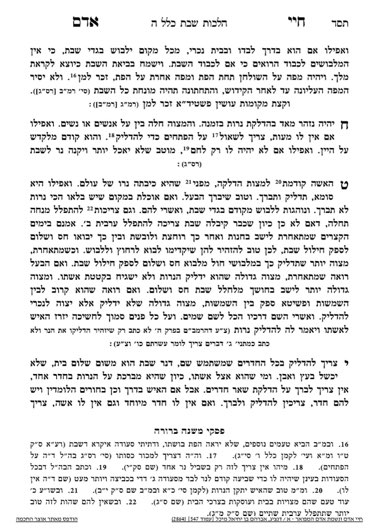We are beginning siman 9. The Chayei Adam writes that although we have learned that the mitzvah of hadlakas neiros applies both to men and women, the woman has precedence over the mitzvah. In other words, if a husband and wife have a disagreement over who should light the neiros, even though it could be argued that it is the husband’s home and his chiyuv to ensure there is light in the house, the primary responsiblity for this mitzvah is placed on women.
The source for this is the Mishnah in Bameh Madlikin that says that hadlakas neiros is one of the three mitzvos which can be called up as an accusation against a woman at the time of childbirth. The Gemara explains that the primary responsibility for hadlakas neiros is placed upon women as a result of the original “candle” which Chavah “extinguished”. When Chavah was convinced by the nachash, she brought death into the world, which caused the eventual death of Adam Harishon. As the soul is compared to a candle, Adam was like the soul of the world and hence like a candle. Every Shabbos, women have the opportunity to bring back a little bit of that light through Shabbos neiros.
Rashi in Shabbos brings a second explanation as well. He writes that since the woman is generally taking care of the home, it is part of the responsibilities of the home to ensure it is lit. The Shulchan Aruch brings this explanation in siman 363.
The Mishnah Berurah points out that according to this second explanation, one would have thought that the responsibility to prepare and set up the neiros would also be her responsibility. However, the Mishnah Berurah writes that husband should take part of the mitzvah by preparing the neiros. We find that preparation of the neiros is not something taken lightly. Regarding the hadlakas neiros in the Mishkan (in parshas Beha’aloscha), Chazal tell us that Hashem reassured Aharon that his korban greater than the nesi’im’s korbanos, because Aharon “prepares and lights the neiros”. Chazal understand that Hashem was not just reassuring Aharon regarding the lighting, but the preparation as well.
Part of the preparations of the husband include preparing the wicks. When using wicks with oil, the wicks do not immediately begin drawing the oil, but rather first wick oil into the wick. If the husband lights the wicks while he is preparing them, he will cause the wicks to wick the oil so that when his wife comes to light, the wicks will immediately begin drawing oil and therefore light quicker. Nowadays, those who use wax or oil with wicks which are coated in wax to light faster, it is arguably no longer necessary. Even so, some people still do it.
The Chayei Adam writes that the mitzvah of hadlakas neiros is the woman’s mitzvah to the extent that even if she is blind, she takes precedence to her husband. She can still make the bracha. If she is completely blind, and gains no benefit from the added light, she should still light, because she still gains from the shalom bayis and kavod Shabbos. However, the Chayei Adam suggests that it would be preferable for her husband to make the bracha.
The idea that one person can make the bracha and another can do the mitzvah is a big chiddush. The Chayei Adam is looking at the woman as a shliach of her husband, and therefore he can make the bracha while she performs the action. We will discuss more ramifications of this idea as we go further, be’ezras Hashem.
Summary
The primary mitzvah of hadlakas neiros is upon the woman, and therefore she takes predence over her husband. However, her husband should prepare the neiros for her.
A woman who is blind but still gains some benefit from the light can still light neiros and make a bracha. However, if she is completely blind, she should light and her husband should make the bracha.


